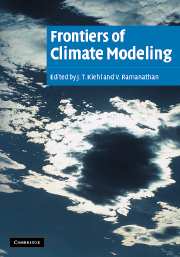Book contents
- Frontmatter
- Contents
- Preface
- List of Contributors
- Acknowledgments
- 1 Overview of climate modeling
- 2 Climate-change modeling: a brief history of the theory and recent twenty-first-century ensemble simulations
- 3 Energy-balance climate models
- 4 Intrinsic climatic variability: an essay on modes and mechanisms of oceanic and atmospheric fluid dynamics
- 5 The radiative forcing due to clouds and water vapor
- 6 A model study of the effect of Pinatubo volcanic aerosols on stratospheric temperatures
- 7 Unresolved issues in atmospheric solar absorption
- 8 Cloud feedbacks
- 9 Water-vapor feedback
- 10 Water-vapor observations
- 11 New frontiers in remote sensing of aerosols and their radiative forcing of climate
- 12 Cloud–climate feedback: lessons learned from two El Niño events
- 13 Runaway greenhouses and runaway glaciations: how stable is Earth's climate?
- Glossary
- Plate section
9 - Water-vapor feedback
Published online by Cambridge University Press: 12 August 2009
- Frontmatter
- Contents
- Preface
- List of Contributors
- Acknowledgments
- 1 Overview of climate modeling
- 2 Climate-change modeling: a brief history of the theory and recent twenty-first-century ensemble simulations
- 3 Energy-balance climate models
- 4 Intrinsic climatic variability: an essay on modes and mechanisms of oceanic and atmospheric fluid dynamics
- 5 The radiative forcing due to clouds and water vapor
- 6 A model study of the effect of Pinatubo volcanic aerosols on stratospheric temperatures
- 7 Unresolved issues in atmospheric solar absorption
- 8 Cloud feedbacks
- 9 Water-vapor feedback
- 10 Water-vapor observations
- 11 New frontiers in remote sensing of aerosols and their radiative forcing of climate
- 12 Cloud–climate feedback: lessons learned from two El Niño events
- 13 Runaway greenhouses and runaway glaciations: how stable is Earth's climate?
- Glossary
- Plate section
Summary
Introduction
As mentioned in the previous chapter, water vapor is an important feedback factor in the climate system. The present chapter considers the observational evidence and modeling for this feedback factor. In 1989, commenting on an article in which Raval and Ramanathan (1989) showed from ERBE data that warmer sea-surface temperatures (SSTs) were associated with greater water-vapor absorption of outgoing radiation, Bob Cess (1989) noted that if the relationship held for climate change as well, the water-vapor feedback would amplify doubled CO2 warming by 60%. What have we learned in the years since then?
As described in Chapter 8, the water-vapor feedback is defined as the response of the atmospheric moisture to changes in climate forced by some other means. The canonical point of view is that when the oceans are forced to warm, say by increasing atmospheric CO2, they will evaporate more moisture into the atmosphere. This effect should occur because the atmospheric water-vapor holding capacity (the saturation vapor pressure) increases exponentially with increasing temperature (via the Claussius–Clapeyron relationship).
Increasing water vapor in the atmosphere will lead to further warming of the surface, as water vapor is itself a greenhouse gas. It absorbs outgoing terrestrial radiation in a broadband continuum from 8–12 m, through rotational bands in the far-infrared (FIR) (> 20 m), and via vibrational–rotational bands near 6.3 m (Harries, 1996).
- Type
- Chapter
- Information
- Frontiers of Climate Modeling , pp. 251 - 284Publisher: Cambridge University PressPrint publication year: 2006
- 1
- Cited by



